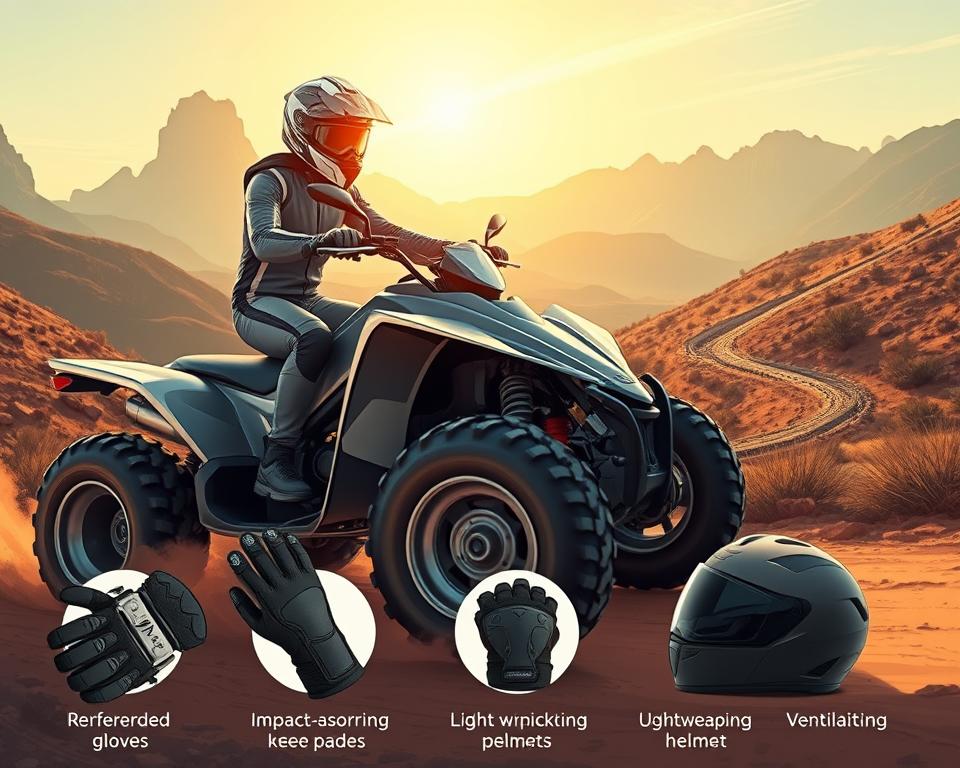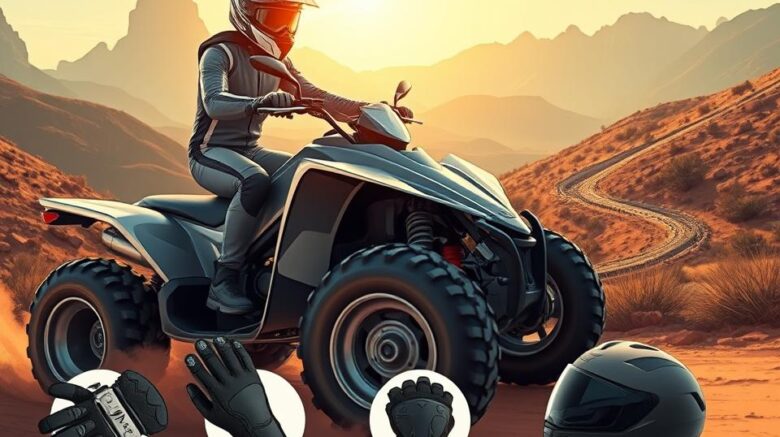Essential ATV Off-Road Checklist for Safe Riding
It’s interesting to note nearly approaching half a million ATV-related injuries are treated in U.S. emergency rooms each year? That startling statistic underscores why off-road safety and preparation are essential. The Essential ATV Off-Road Checklist is your guide to a safe and enjoyable ride. It covers everything from rocky trails to sand dunes. With the right safety gear and Can Am with plow essentials, you can minimize risks and boost your adventure.
Core Lessons
- Prioritize safety by using the Essential ATV Off-Road Checklist for optimal preparation.
- An ATV safety gear checklist is vital for protecting yourself during off-road rides.
- Keep your ATV running smoothly with routine care.
- Hydration and nutrition boost endurance and focus on long rides.
- Learn to use navigation tools to avoid getting lost on off-road routes.
- Be ready for unexpected weather changes to stay comfortable during your adventure.
- Always carry essential tools and recovery kits for on-trail repairs and emergencies.
Understanding the Importance of Safety Gear
When you ride off-road, safety must come first. The excitement of ATVs brings potential hazards. Safety gear is essential for protecting riders from accidents and injuries. A full gear check means a safer outing.

Essential Protective Gear
Maximizing protection involves several key items:
- Riding Helmets: Always use a DOT helmet to guard against head trauma.
- Goggles: Use goggles to shield your eyes from dust and debris.
- Gloves: Grip and guard your hands with sturdy gloves.
- Boots: High boots shield your feet and ankles.
- Protective Armor: Aggressive riders should consider body armor for extra security.
- Neck Protection: A neck brace protects your spine in a crash.
Emergency Preparedness
Being ready for emergencies is critical. A well-packed kit might save your life. Key items to include are:
- First aid kit
- Multi-tool
- Tire repair kits
- Portable air compressors
- Emergency blankets
- Whistles
- Matches
ATV Equipment for Optimal Performance
The right kit makes all the difference. Pack these essentials for any trail. Regularly following an ATV maintenance checklist helps maintain your machine’s functionality and longevity.
Must-Have ATV Equipment
- All-Terrain Tires: Choose tires that grip mud, sand, and rocks.
- Storage Solutions: Mount racks or bags to carry your gear safely.
- Quality Fuel Tank: A high-quality fuel tank prevents leaks and ensures you have enough fuel for extended rides.
- First Aid Kit: Stock your kit with bandages, antiseptic, and meds.
Regular Maintenance for Longevity
Establishing a consistent maintenance routine is vital. Regular inspections should encompass:
- Checking air filters to keep the engine running smoothly.
- A well-lubed chain spins quietly and reliably.
- Ensure pads and discs are in prime condition.
Stay on top of upkeep and your ATV will perform its best.
The Essential ATV Off-Road Checklist
Preparing for a ride is more than just hopping on your ATV. An effective ATV maintenance checklist ensures your vehicle’s safety and performance. Every point matters—don’t rush. A thorough pre-ride assessment is key to a safe outing.
Pre-Ride Inspection Basics
Before any off-road journey, a pre-ride inspection is vital. Find and fix small problems before they grow. Key elements to check include:
- Tire pressure and tread condition
- Fluid levels such as oil and fuel
- Brakes and controls functionality
- Operational lights and horn
- Chain or driveshaft integrity
T-CLOC Inspection Method
Use T-CLOC for a thorough pre-ride check. Tires, Controls, Lights, Oil/Fuel, Chain—don’t miss a spot. This method ensures all critical areas are covered:
| Inspection Area | Checklist Items |
|---|---|
| Tires and Wheels | Check tire pressure, inspect tread depth, look for damage |
| Controls | Test brakes, throttle, and clutch for smooth operation |
| Lights | Ensure headlights, brake lights, and indicators are functioning |
| Oil and Fuel | Check oil level, inspect for leaks, and fill fuel tank |
| Chain/Driveshaft | Examine for wear, proper tension, and lubrication |
Check everything—ride with confidence. By checking these essential components, riders can avoid breakdowns.
Hydration and Nutrition for Long Rides
Long ATV rides require careful attention to hydration and nutrition. Always carry more water than you think you’ll need. Hydration packs make water access easy on the trail. Pack high-energy bites to keep you going.
Importance of Staying Hydrated
Drink often—don’t wait for thirst. A hydration pack with sip tube makes it easy. Hydration bladders track consumption at a glance.
High-Energy Snacks to Pack
Good snacks keep you sharp and energized. Opt for non-perishable items that are easy to consume. Some ideal choices include:
- Protein bars
- Nut mixes
- Dried fruits
- Beef jerky
Snack smart for sustained energy. Ensure to pack a variety to keep your energy levels high and your taste buds satisfied.
Navigation Tools for Off-Roading Adventures
Exploring uncharted territory demands reliable navigation tools. Don’t rely on luck or signals—use real navigation.
Advanced GPS Systems
High-end GPS units guide you through the wild. Choose units with rugged builds, offline charts, and extended runtime. Brands like Garmin and TomTom offer models designed for off-road use, ensuring durability and precision.
Traditional Navigation Aids
Technology is key, but traditional tools are also essential. Maps won’t die when batteries do. Map-and-compass know-how keeps you in control. Tech plus tools equals total navigation readiness.
Communication Equipment for Safety
When phones fail, two-way radios deliver. Clear comms keep your group coordinated. It gives riders peace of mind.
Group rides need reliable radios. Pick units with strong, clear signal range. Get instant alerts about obstacles ahead. When choosing two-way radios, look for models with:
- Weatherproof construction to resist the elements
- Extended run-time for extended trips without needing a recharge
- Multiple channels for clear communication without interference
Always include comms in your gear list. They keep everyone coordinated and secure. They provide a vital communication line in tough environments. Clear comms = better rides.
Self-Rescue Gear for ATV Riders
Don’t be caught unprepared—pack rescue gear. With the right kit, you’ll tackle obstacles solo. Being self-sufficient elevates confidence and safety.
Winches and Recovery Kits
A winch can drag you out of any rut. Combine winch power with the right accessories. Recovery kits usually include:
- Tow straps
- D-rings
- Recovery boards
- Gloves
Knowledge plus gear equals true self-rescue. Be ready for anything the trail throws at you.
Trail Recovery Essentials
Pack these extras along with your winch. These include:
| Equipment | Purpose |
|---|---|
| Recovery Straps | Used for towing or pulling ATVs out of tight situations. |
| Shovel | Helps clear obstacles and dig out vehicles when stuck. |
| Traction Mats | Provides grip under tires in muddy or slick conditions. |
| Portable Air Compressor | Enables quick tire inflation after deflating for better traction. |
Don’t rely on luck—bring the right tools. Knowing how to use these tools greatly improves safety and adventure on your off-road excursions.
Staying Adaptable: Preparing for Weather Changes
Trail weather can change in minutes. Be prepared for sun, rain, or wind at any moment. Pack for every possible forecast.
Layering your clothes is key to adapting to temperature changes. A dry base keeps you cozy. Then, add insulating layers like fleece or wool that can be removed as needed. Lastly, have a waterproof and wind-resistant outer shell. This setup ensures you stay comfortable, no matter the weather.
Weather-Appropriate Clothing
- Waterproof Jackets: A must-have for sudden downpours.
- Breathable Pants: Pants that vent yet keep out the rain.
- UV Gear: Sun-blocking shirts and hats prevent overexposure.
- Insulated Gloves: Warm gloves maintain dexterity in chill.
Quality weather gear is a must for a great off-roading experience. Stay focused on the trail, not on being wet or cold.
Tools for On-Trail Repairs
Essential repair tools are a rider’s best friend. Pack tools you trust. These tools help address minor breakdowns or issues that may arise during your adventure.
Must-Have Tools and Kits
A well-prepared rider should assemble a basic tool kit. A compact kit with everything you need. Critical ATV repair tools might include:
- Tire irons for changing flat tires
- Pliers for gripping and cutting
- Wrenches for various sizes of bolts and nuts
- A multi-tool for versatility
- Spare items such as spark plugs and electrical wire
- Duct tape for quick fixes
Be your own mechanic on the trail.
Basic Emergency Supplies
In addition to essential tools, packing basic emergency supplies for ATV is vital. These supplies help ensure your safety in challenging situations:
- First aid kit for injuries
- Flashlight with extra batteries for night-time visibility
- Emergency whistle for signaling assistance
- Reflective triangles or flares to warn other riders
- Water and high-energy snacks for sustenance
Preparation pays off big time. Always keep these ATV repair tools and emergency supplies handy.
As a Final Point
Well-planned rides are the best rides. Follow this checklist and choose quality gear. Ride confidently on every surface.
Load up on safety, navigation, and comms gear. Effective planning is vital for both safety and performance. Focus on fun, not fears.
Gear up, stay sharp, and savor every off-road second. The journey is as important as the destination. By following the Essential ATV off-road checklist, you’re set for an incredible adventure in the great outdoors.
Frequently Asked Questions
What must an ATV safety checklist cover?
Your ATV safety gear checklist should include a DOT-approved helmet and goggles. Add gloves, boots, and torso protection. Neck braces offer additional protection. Remember to pack an emergency kit with a first aid kit and multi-tools for preparedness.
Tips for ATV upkeep?
Inspect air filters and grease the chain often. Don’t ignore brake checks. A consistent maintenance routine extends your machine’s life and keeps it ready for off-road adventures.
Explain the T-CLOC check.
T-CLOC inspects five critical systems. It includes checking Tires and Wheels, Controls, Lights, Oil and Fuel, and Chain/Driveshaft. T-CLOC confirms all systems go for trail use.
How to gauge water needs off-road?
Carrying more water than you think you’ll need is essential. Stay topped off to avoid dehydration. Hydro packs let you drink without stopping.
How to stay on course off-road?
Use an off-road GPS unit. Also carry a compass and laminated maps.
Why is communication important when off-roading?
Comms keep groups connected and safe. Areas with limited cell service highlight the need for reliable two-way radios.
What self-rescue gear should every ATV rider carry?
Every ATV rider should carry a winch and a detailed recovery kit. This kit should include tow straps, D-rings, and recovery boards.
How can I prepare for sudden weather changes while off-roading?
Use a base, mid, and shell layering system. Pack a rain shell to stay dry. Don’t forget sunscreen and UV-blocking apparel.
Key repair tools for ATVs?
A compact tool set lets you fix flats and loose bolts. Have spares and tape for quick fixes.
